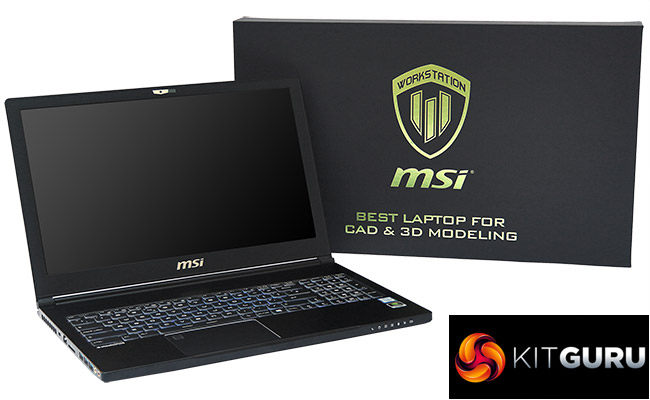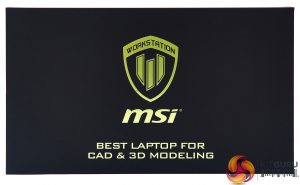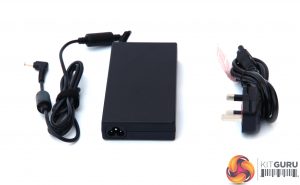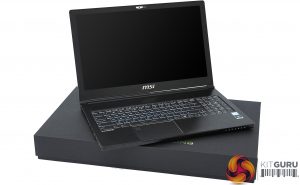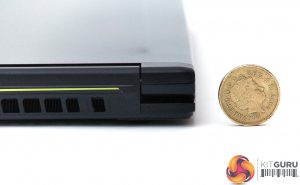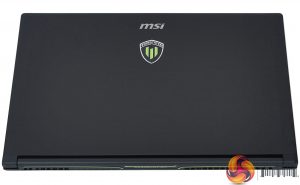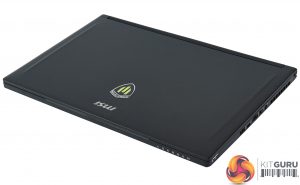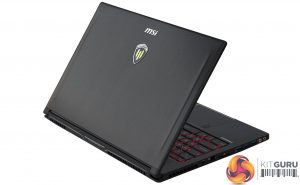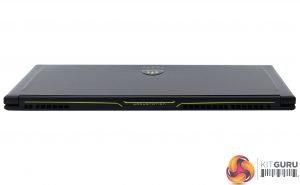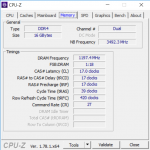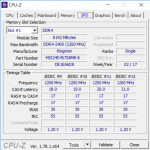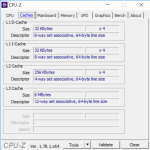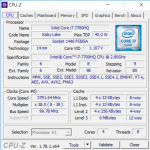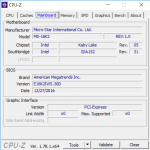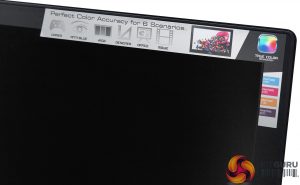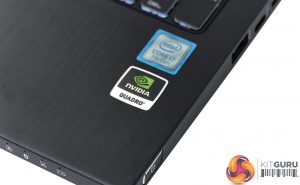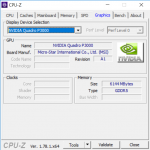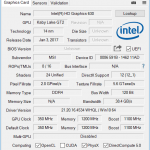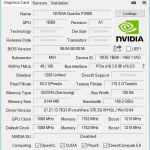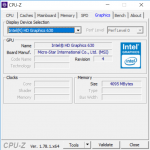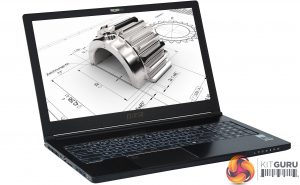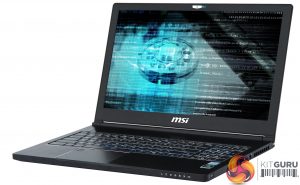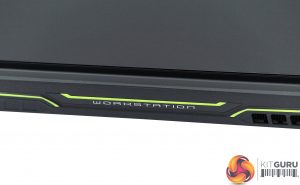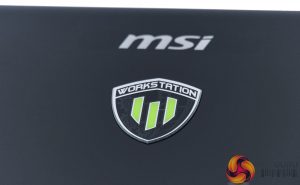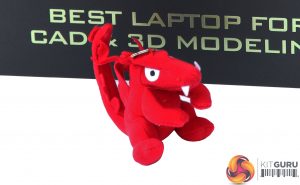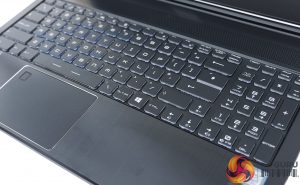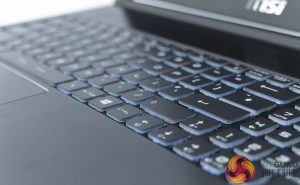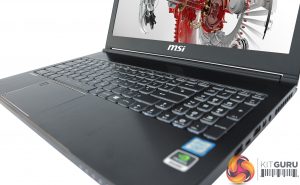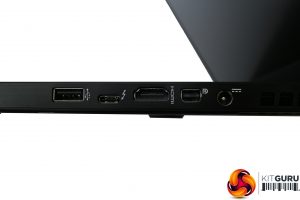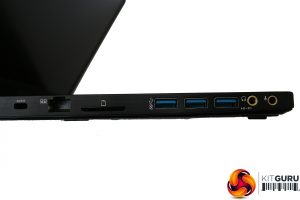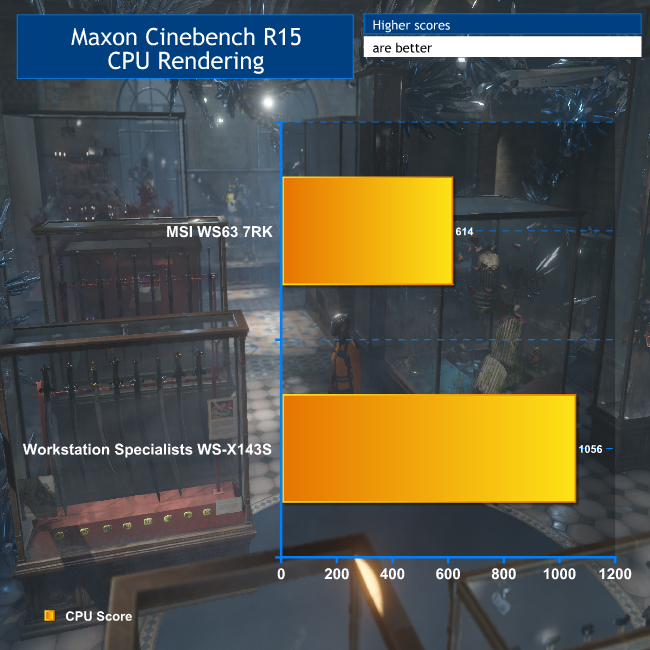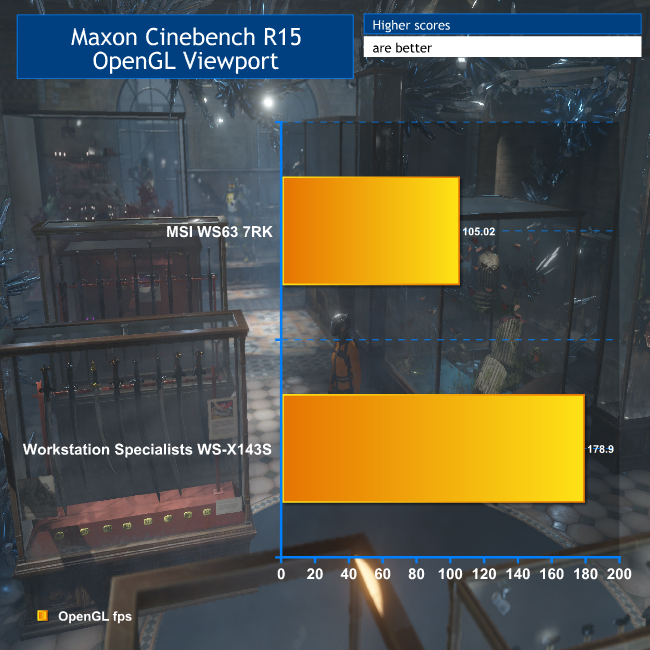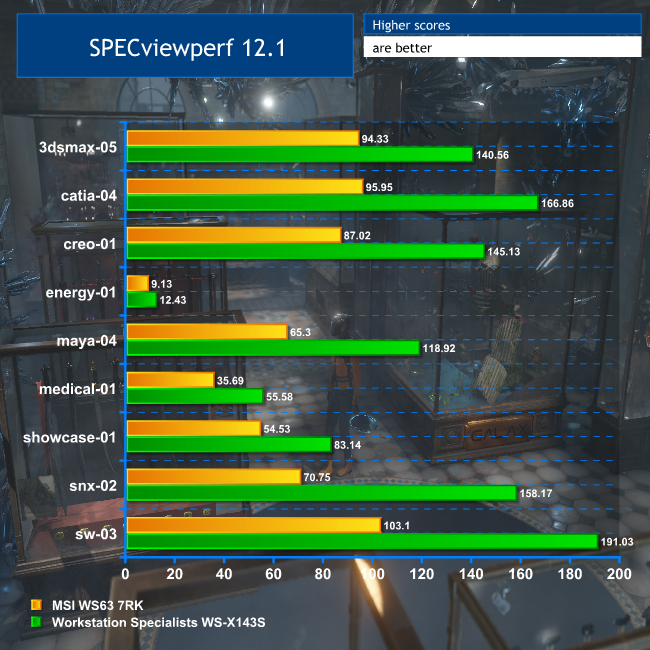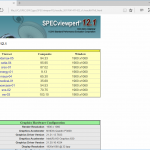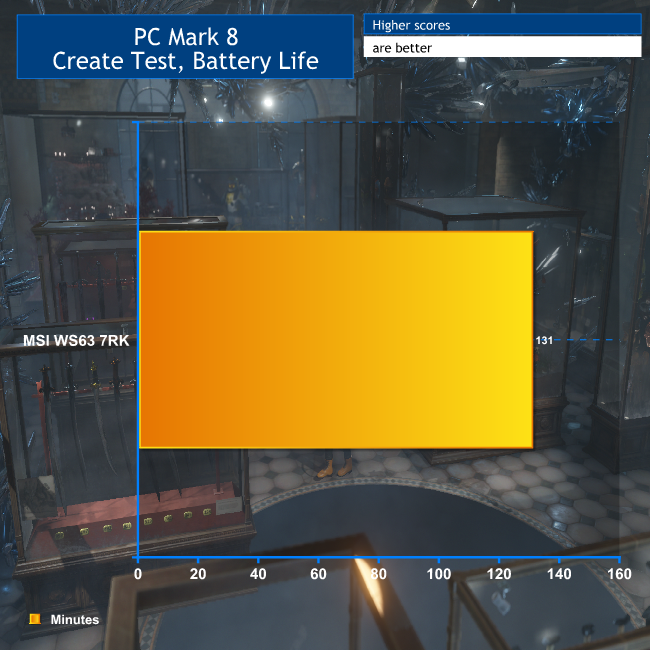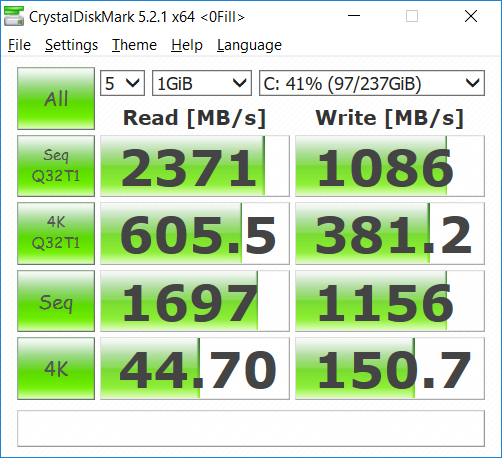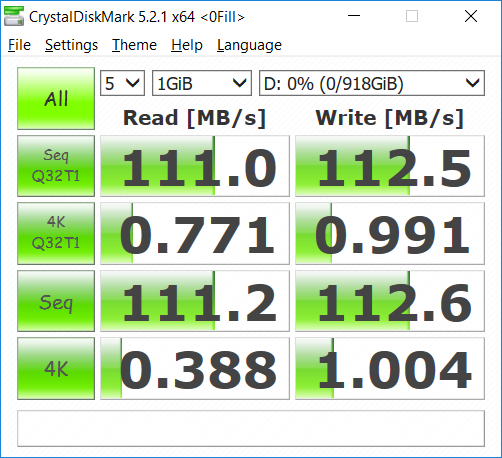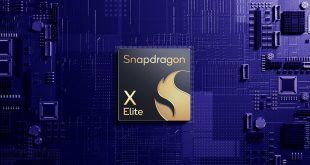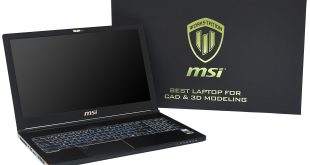
Mobile workstations are usually only mobile in the sense that you can move them from desk to desk more easily than a full tower. They are not generally systems you would want to carry around with you all day. But the MSI WS63 7RK bucks this trend. It’s under 2cm thick and under 2kg in weight. Yet inside is a quad-core processor, professional NVIDIA Quadro graphics, and two storage devices.
The processor in question is an Intel Core i7-7700HQ. This is from the Kaby Lake generation, but is the lowest-specified mobile quad-core from the range. The CPU is backed by 16GB of DDR4 SDRAM. The NVIDIA Quadro graphics is the very latest Pascal-generation P3000, with 6GB of GDDR5 memory, so should give desktop professional 3D accelerators a run for their money. With a 15.6in Full HD IPS panel on board, there’s plenty of potential for serious 3D work.
Storage includes a 256GB Toshiba M.2 NVMe solid state disk for operating system and apps, plus a 1TB HGST Travelstar Z5K1000 5,400rpm conventional hard disk offering plenty of capacity. So this really is like a mini workstation you can carry around with you. Let’s find out how closely it compares to a workstation you wouldn’t be able to fit in a bag.
MSI W63 7RK Specifications:
- Intel Core i7-7700HQ @ 2.8GHz
- 16GB DDR4 SDRAM @ 2,400MHz
- 6GB GDDR5 NVIDIA Quadro P3000 Graphics
- Intel HD Graphics 630
- 15.6in IPS TFT with 1,920 x 1,080 resolution
- 256GB Toshiba THNSN5256GPU7 M.2 NVMe SSD
- 1TB HGST Travelstar Z5K1000 SATA III 6Gb/s 5,400rpm HDD
- Networking: Gigabit Ethernet, 802.11ac WiFi, Bluetooth v4.2
- Ports: LAN, SDXC, 1 x USB 3.1 Type C, 3 x USB 3.0, 1 x USB 2.0, Mini DisplayPort, HDMI, heaphone / S/PDIF, microphone
- Dimensions (WxDxH): 380 x 249 x 17.7mm
- Weight: 1.8kg
- Windows 10 Professional 64bit
- 3 Years warranty, including 1 Year Global
Price: £2,379.29 inc VAT & Delivery (Buy from LambdaTek HERE)
The WS63 7RK arrives in an attractive box, but apart from the notebook itself, there's not much in it other than the power supply and mains cable.
The WS63 7RK isn't thin-and-light, but it's hardly a porker either. At just 17.7mm thick, this is a nice notebook to carry around, considering the powerful components within. It weighs 1.8kg, which isn't hefty when many mobile workstations will be pushing towards the 3kg mark.
This is an attractive notebook for the intended user, too. It's not particularly “bling”, but it's also not sober and boring. Considering that it's aimed at high-end content creation work, you don't want a system that is either totally uninspiring or too snazzy for clients to take you seriously. MSI has the appearance just about right, somewhere in between the two.
The Intel Core i7-7700HQ may be the least well endowed mobile Kaby Lake quad-core, but whilst it has a nominal clock speed of 2.8GHz, the top single-core Turbo mode is 3.8GHz, with two cores able to run at 3.6GHz and all four at 3.4GHz.
Naturally, there's Intel's Hyper-Threading on board to turn the four physical cores into eight virtual ones, too. So this is a pretty potent processor whether it's single-core clock speed or multi-core performance you're after.
The processor is backed by 16GB of 2,400MHz DDR4 SDRAM, supplied as two SODIMMs. This is a very decent amount of memory, but the system has a maximum of 32GB, which would be a better choice if you're planning intensive 3D design work.
There are two graphics accelerators available. The Intel HD 630 is built into the CPU, and will be on call when activities don't require significant 3D acceleration. It should keep the power consumption down.
But if you're doing intensive 3D work, the HDD 630 won't cut the mustard, which is where the NVIDIA Quadro P3000 graphics will fire up and take over. This is a great professional mobile GPU, approximately equivalent to the GeForce GTX 1060. It sports a hefty 1,280 CUDA cores, running at 1,088MHz or 1,215MHz in Boost mode.
There's a very commendable 6GB of GDDR5 frame buffer as well, on a 192-bit bus, providing 168.2GB/sec of bandwidth. This is a little behind the mainstream high-end desktop P4000, but overall it's extremely potent for professional mobile graphics.
The 15.4in screen is a joy to behold. Since it uses IPS technology, it's bright and the colours are very faithful. Viewing angles are also excellent. The resolution is 1,920 x 1,080, which is just about right for a panel this size, although a UHD 3,840 x 2,160 option is also available. There's a 720p webcam in the middle of the top of the bezel.
MSI has taken the now traditional workstation route of supplying a solid state disk for applications and software, alongside a cheaper, more capacious mechanical hard disk for general data. The SSD is a Toshiba THNSN5256GPU7 M.2 NVMe PCI Express 4x unit, which should ensure fast boot and application load times. The hard disk is a 5,400rpm HGST Travelstar Z5K1000, which will be quite a lot slower than the SSD, but has 1TB of capacity on offer, so provides plenty of room for content creation assets such as video files.
The chiclet-style keyboard is comfortably sized, with a separate keypad on the right. The action is responsive and touch-typing is ergonomic. The hash key is in a slightly unorthodox place, however, and the Enter key wider but only one key deep. So this takes a little getting used to. There's backlighting so you can see the keys properly in a dark environment.
Sensibly, the one-piece trackpad has been placed off centre directly beneath the space bar, so that when you're touch typing the risk of brushing the trackpad with the heel of your hand is minimised. This is great, when so many manufacturers put design first and place the trackpad centrally to the wrist rest, causing unnecessary pointer movement. It's also not the most responsive example, although not annoyingly so, once you're familiar with its foibles.
On the right-hand side there is a single USB 2.0 Type-A port, with a USB 3.1 Type C port next door, then full-sized HDMI and Mini DisplayPort, and finally the power connector. The left-hand side is home to the Kensington lock slot, Gigabit Ethernet, SDXC card slot, three USB 3.0 Type A ports, and separate minijacks for headphones and microphone. The headphone output also doubles as digital S/PDIF. Wireless connectivity includes 802.11ac WiFi and Bluetooth 4.2.
We put the MSI WS63 7RK through a series of workstation benchmarks. For comparison, we pitted it against a Workstation Specialists WS-X143S desktop workstation with a NVIDIA Quadro P4000 graphics card fitted. This was the closest system we had to hand in terms of specification in a desktop format. It's a small form factor workstation, but using desktop components rather than mobile ones, so with the same performance as larger systems.
Software:
Cinebench R15
SPECviewperf 12.1
CrystalDiskMark 5.2.1
Futuremark PC Mark 8 (battery test only)
Workstation Specialists WS-X143S Specifications:
- Intel Core i7-7700K @ 5GHz
- 32GB DDR4 SDRAM @ 2666MHz
- 256GB Samsung SM961 M.2 PCIe x4 SSD
- 1TB Seagate Barracuda SATA III 6Gb/s 7,200rpm HDD
- 8GB GDDR5 NVIDIA Quadro P4000 Graphics
- Windows 10 Pro 64bit
CINEBENCH 15 is a cross-platform testing suite that measures hardware performance and is the de facto standard benchmarking tool for leading companies and trade journals for conducting real-world hardware performance tests. With Release 15, systems with up to 256 threads can be tested.
CINEBENCH is available for both Windows and OS X and is used by almost all hardware manufacturers and trade journals for comparing CPUs and graphics cards.
The CPU rendering portion of Maxon Cinebench R15 shows that the WS63 7RK's quad-core is quite a way behind the 5GHz Intel Core i7 7700K quad core in our desktop reference workstation. However, it's also not an embarrassing result, and most professionals will only be doing the odd test render on a notebook, transferring their work to a meatier desktop or render farm for final output. For this scenario, the WS63 7RK will be just fine.
The Cinebench OpenGL results also look a bit disappointing, but this test is very sensitive to clock speed, and our desktop reference's 5GHz processor and NVIDIA Quadro P4000 graphics give it a real edge. A score over 100 is a very acceptable result for a notebook, nevertheless.

SPECviewperf 12.1, released by SPEC's Graphics Performance Characterization group (SPECgpc) on August 24, 2016, is the latest version of the worldwide standard for measuring graphics performance based on professional applications. SPECgpc members at the time of release include AMD, Dell, Fujitsu, HP, Intel, Lenovo, NEC and NVIDIA.
SPECviewperf 12.1 measures the 3D graphics performance of systems running under the OpenGL and Direct X application programming interfaces. The benchmark’s test files, called viewsets, represent graphics content and behavior from actual applications.
The desktop's NVIDIA's Quadro P4000 is clearly way ahead of the WS63 7RK's mobile P3000. The P4000 has 1,792 CUDA cores compared to the P3000's 1,280, so the performance differential is understandable. But these are still great scores in all areas, for a notebook.
The 3dsmax-05 and maya-04 results show the WS63 7RK will be very capable for 3D modelling and animation. The sw-03 and catia-04 scores show that product design and engineering will be top notch, too.
We tested the MSI WS63 7RK with Battery Saver turned on and a 50 per cent screen brightness, using the PC Mark 8 Create battery test, which runs a series of productivity tasks until the power runs out. These test scripts stress the graphics performance a little, although not specifically professional 3D. It's supposed to represent a mixture of everyday creative tasks.
The result of around two hours isn't stunning, but this is quite an intensive set of activities. Nevertheless, we would have liked to see an hour longer. Two hours of creative work away from the power plug is useful, but not outstanding. If you're only using the system for the odd bit of word processing and Web browsing, however, you should be able to expect at least twice the duration. We achieved around five hours of non-intensive activities.

Crystalmark is a useful benchmark to measure theoretical performance levels of hard drives and SSD’s. We are using V5.2.1 x64.
The Toshiba SSD is very quick indeed. The sequential read rate of 2,371MB/sec is phenomenal, and makes for extremely fast boot times and software loading.
The 1TB HGST Travlestar Z5K1000 hard disk is quite speedy for a 2.5in SATA notebook drive. However, the sequential read rate of 111MB/sec is 20 times slower than the SSD.
The MSI WS63 7RK is a hugely capable mobile workstation. You're still not getting all the performance of a desktop in a notebook form, but there is a very useful amount of professional 3D and content creation power available here.
The specification is also very sensibly balanced. The IPS screen is excellent, and storage very useful, with a hugely quick SSD for fast operating system and software loading, plus a capacious 1TB conventional hard disk with reasonable throughput for general storage. The keyboard is comfortable and lots of cutting edge ports are available for connecting external devices.
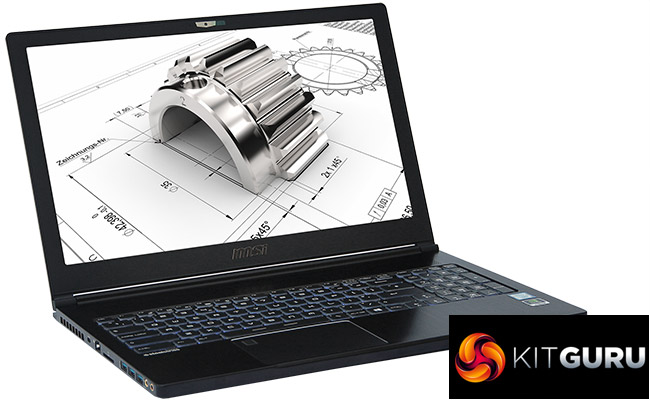
The only significant downside is that you only get a little over two hours of creative work before the battery will be spent. This is a shame, considering how portable this mobile workstation is. You really can carry it around with you without causing shoulder strain or bag breakage.
Overall, though, this is a reasonable compromise for such a capable professional portable, although you pay a premium for the capabilities.
Price: £2,379.29 inc VAT & Delivery (Buy from LambdaTek HERE)
Discuss on our Facebook page, over HERE.
Pros:
- Great for modelling on the move.
- Reasonable rendering for a notebook.
- Thin and light, considering the power.
- Fast primary SSD.
- Generous storage.
Cons:
- Only two hours of creative work on battery.
- Fairly pricey.
Kitguru says: The MSI WS63 7RK is a very capable mobile workstation in a exceedingly portable package.

Be sure to check out our sponsors store EKWB here
 KitGuru KitGuru.net – Tech News | Hardware News | Hardware Reviews | IOS | Mobile | Gaming | Graphics Cards
KitGuru KitGuru.net – Tech News | Hardware News | Hardware Reviews | IOS | Mobile | Gaming | Graphics Cards


